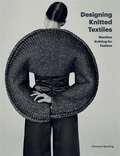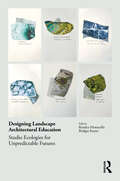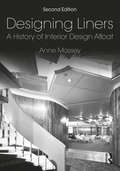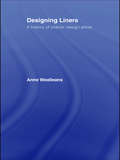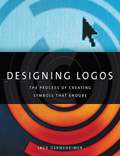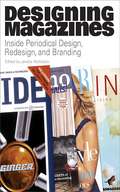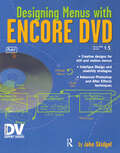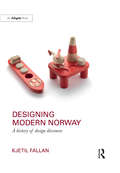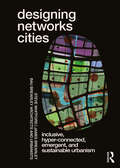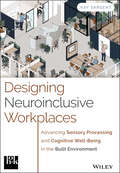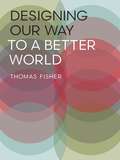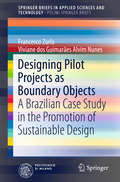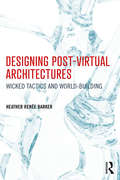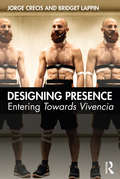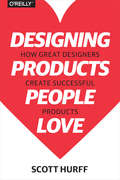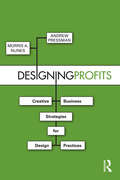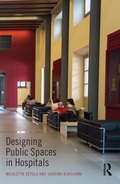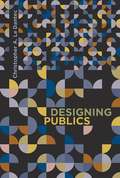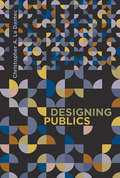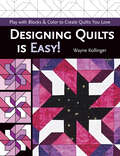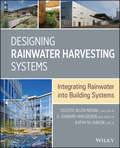- Table View
- List View
Designing Knitted Textiles: Machine Knitting for Fashion
by Florence SpurlingDesigning Knitted Textiles guides readers through the fundamental skills of machine knitting, while encouraging them to be creative and experimental. It takes a contemporary approach, exploring the countless possibilities of machine-knitted textiles within multiple fashion contexts.Part 1 offers a practical introduction to the subject, with step-by-steps and detailed information on tools, stitch types, fibres and techniques. Part 2 covers colour, pattern, texture, structure and embellishment, highlighting a range of designs from traditional styles such as Fair Isle to the most intricate lace or unusual 3D effects. Finally, Part 3 delves into the construction elements needed to create garments and accessories.Praise for Designing Knitted Textiles from academic reviewers:'Perfect for beginners' knitwear course, to get a rounded understanding of the machine and capabilities'. - GEMMA MARSH, SAVANNAH COLLEGE OF ART AND DESIGN'It covers a wide range of single bed machine knitting techniques and includes inspirational images of knitted samples and garments. The book features technical information explaining how to knit many of the stitches, with clear diagrams and useful tips and hints. I will be recommending this book to all levels, as it has something to offer even the more experienced final year student'. DR VIKKI HAFFENDEN - UNIVERSITY OF BRIGHTON'This is a very clear a concise approach to machine knitting and design'. JOSEPH PESCATORE - NASSAU COMMUNITY COLLEGE'The book is beautifully written with a lot of excellent illustrations. The pictures of knitted designs are inspiring and relevant to contemporary fashion. An overall excellent book'. NICOLAS CHAMPROUX - HOUSTON COMMUNITY COLLEGE'This book has great illustrations and clear, easy-to-read text. There is a wide breadth of knowledge and a variety of techniques represented, and the tips are succinct and helpful. Equally appreciated are the many sources of knitwear inspiration'.MEGHAN KELLY - THOMAS JEFFERSON UNIVERSITY
Designing Knitted Textiles: Machine Knitting for Fashion
by Florence SpurlingDesigning Knitted Textiles guides readers through the fundamental skills of machine knitting, while encouraging them to be creative and experimental. It takes a contemporary approach, exploring the countless possibilities of machine-knitted textiles within multiple fashion contexts.Part 1 offers a practical introduction to the subject, with step-by-steps and detailed information on tools, stitch types, fibres and techniques. Part 2 covers colour, pattern, texture, structure and embellishment, highlighting a range of designs from traditional styles such as Fair Isle to the most intricate lace or unusual 3D effects. Finally, Part 3 delves into the construction elements needed to create garments and accessories.Praise for Designing Knitted Textiles from academic reviewers:'Perfect for beginners' knitwear course, to get a rounded understanding of the machine and capabilities'. - GEMMA MARSH, SAVANNAH COLLEGE OF ART AND DESIGN'It covers a wide range of single bed machine knitting techniques and includes inspirational images of knitted samples and garments. The book features technical information explaining how to knit many of the stitches, with clear diagrams and useful tips and hints. I will be recommending this book to all levels, as it has something to offer even the more experienced final year student'. DR VIKKI HAFFENDEN - UNIVERSITY OF BRIGHTON'This is a very clear a concise approach to machine knitting and design'. JOSEPH PESCATORE - NASSAU COMMUNITY COLLEGE'The book is beautifully written with a lot of excellent illustrations. The pictures of knitted designs are inspiring and relevant to contemporary fashion. An overall excellent book'. NICOLAS CHAMPROUX - HOUSTON COMMUNITY COLLEGE'This book has great illustrations and clear, easy-to-read text. There is a wide breadth of knowledge and a variety of techniques represented, and the tips are succinct and helpful. Equally appreciated are the many sources of knitwear inspiration'.MEGHAN KELLY - THOMAS JEFFERSON UNIVERSITY
Designing Landscape Architectural Education: Studio Ecologies for Unpredictable Futures
by Rosalea Monacella and Bridget KeaneNo single project or endeavour is immune to the issues that the climate crisis brings. The climate crisis encompasses a broad register of "symptoms" – increased global temperatures and sea-level rise, droughts and extreme bushfire events, salinification and desertification of fertile land, and the list goes on. It reveals and amplifies complex causal relationships that are inherently present and traverse scales, sectors and communities divulging a range of impacts and inequalities. This publication asks designers and academic practitioners to describe their own work through an ecological lens, and then to articulate design approaches for developing new practices in landscape architecture teaching. Designing Landscape Architectural Education: Studio Ecologies for Unpredictable Futures, the Landscape Architecture Design Studio Companion, serves as a resource for academic practitioners in the preparation and delivery of "design-research studios" and students seeking guidance for design methodologies as a part of their landscape architectural education. It draws on the manifold issues of the climate crisis as a set of drivers to examine the utilisation of a range of innovative design approaches to address the current and future priorities of the discipline. The landscape architecture discipline is evolving rapidly to respond to both a broadening and intensification of changes in the environmental, social and political conditions. These changing conditions require innovation that extend the core competencies of landscape architects. This book addresses two fundamental questions – what are the design competencies required of landscape architects to equip them to deal with the complexities brought forth by contemporary society, and as a result, how could we design the future design studio?
Designing Liners: A History of Interior Design Afloat
by Anne MasseyDesigning Liners: A History of Interior Design Afloat covers the interior design of these floating palaces from the mid-nineteenth century to the twenty-first century. In this new edition, the design heritage of the ocean liner is also explored in this age of a growing holiday cruise market. The book offers the first history and analysis of this highly significant aspect of the design of interiors, which mirrors and reinforces cultural assumptions about national identity, gender, class and ethnicity. The interiors of ocean liners reflect the changing hierarchies of society and shifting patterns of globalization. The trajectory of the professionalization of interior design is the connecting narrative of the book, from the local decorating firm to the internationally renowned architect. It is an important addition to interior design research and takes this transitory building type as its subject. This book provides the first survey of the transient history of interior design in relation to the development of passenger shipping. The history of these great ship interiors is tracked, from their commissioning by the line owners; the materials, methods and sources for the initial creation; their construction; their use and reception. The demise and re-purposing of the interiors is also covered in this new edition, with additional material on the South African Union Castle and P & O lines. Drawing on a broad range of original research, Anne Massey’s approach combines interior design studies, design history, architectural history and maritime studies. The new edition has been carefully designed to include black and white and colour illustrations.
Designing Liners: A History of Interior Design Afloat
by Anne WealleansThis in-depth history of the interior design of ocean liners surveys the transient history of interior design in relation to the development of passenger shipping, from commissioning by the line owners, methods and sources for the original creation of designs through to its construction, use and influence. It is a short-lived branch of architecture and design, lasting an average of fifteen years. As the design and taste mirrors and reinforces cultural assumptions about national identity, gender, class and race, not only did the interiors of ocean going liners reflect the changing hierarchies of society and shifting patterns in globalization, but the glamour and styling of the liners were reflected back into the design of interiors on land. Combining design history, architecture history, material and visual cultures, Designing Liners is a richly multidisciplinary work for those studying or researching this application of interior design.
Designing Logos: The Process of Creating Symbols That Endure
by Jack GernsheimerHow to design great logos, step by step by step. * Lavishly illustrated with 750 color images * How-tos, case studies, and detailed analysis of well-known logos What makes a logo good? What makes it bad? What makes it great? The entire process of logo design is examined, from the initial client interview to brainstorming, from first presentation to delivery of the final standards manual. Through 750 color illustrations, classic logos are analyzed, and readers will learn a thirteen-point system for measuring the effectiveness of any logo. Learn about the uses of positive and negative space, balance, color, and typography; follow intriguing case studies; discover how to make effective presentations to clients. Designers, marketing and branding specialists, educators, and students everywhere need this definitive guide to creating great logos.
Designing Luxury Brands: The Art and Science of Creating Game-Changers (Management for Professionals)
by Diana DervalThis book, a second offering after the successful first edition, shows how to build successful luxury brands using the power of sensory science and neuropsychology. The author presents inspiring business cases like Tesla Cybertruck, Chanel, KaDeWe, Baccarat, JACQUEMUS, NASA, MUD Jeans, Lilium, Rémy Cointreau, FENG J, Moncler, Louboutin, or Raffles Dubai in industries such as Fashion, Automotive or Leisure. The book highlights groundbreaking scientific methods - like the Derval Color Test® taken by over 30 million people - to help predict luxury shoppers’ preferences and purchasing patterns. Game-changing and unique features of successful luxury brands are decoded. Through various practical examples and experiments, readers will be able to build, revamp, or expand luxury brands and look at luxury from a new angle.
Designing Magazines: Inside Periodical Design, Redesign, And Branding
by Jandos RothsteinHow does a designer create graphic solutions to the behind-the-scenes editorial challenges at a magazine? Designing Magazines is the complete guide to understanding the inner workings of magazines and their day-to-day management--and a great guide to using that knowledge to create visually stunning, editorially effective magazines, in both new designs and rebranding. Thirty-five experienced editors, designers, and consultants, all at the top of their fields, present their insights on the goals and process of magazine design. Chapters focus on problems faced by designers, ethical considerations, the future of the field, and many more relevant but rarely discussed issues. A look at magazines that have risen above the crowd to achieve special social importance--and how design has been a part of that success--provides additional inspiration for magazine designers everywhere.
Designing Menus with Encore DVD
by John SkidgelDesigned to complement the Encore DVD software documentation, this full-color book begins with a brief description of the DVD specification, then introduces readers to DVD authoring concepts such as menu creation, timeline construction, navigation, transcoding, and disc mastering. Readers learn how to plan and manage projects, and how to master the workflows between Encore and other Adobe applications such as Photoshop, Premiere, and After Effects to create well-structured and engaging menus. The companion DVD contains documents for planning a DVD, tutorial projects, and a library of royalty free, customizable, templates.
Designing Mind-Friendly Environments: Architecture and Design for Everyone
by Steve MaslinExploring the impact of the built environment and design on people with a range of neurological experiences, including autism, dementia, dyslexia and dyspraxia, this comprehensive guide provides project commissioners, architects and designers with all the information and personal insight they need to design, create and build 'mind-friendly' environments for everyone.Assimilating knowledge from medical, therapeutic, social and educational spheres, and using sensory integration theory, the book explores the connection between our minds and our surroundings and considers the impact of the environment on the senses, well-being and neurodiverse needs of people. The book shows how design adaptations to lighting, acoustics, temperature, surfaces, furniture and space can positively benefit the lives of everyone across a range of environments including workplaces, retail, sport and leisure, domestic, educational institutions, cultural and civic spaces, outdoor spaces and places of worship.Universal in its approach and written by an experienced architect and inclusive design consultant, this book is essential reading for professionals in architecture and design, education, organisational psychology, business management and occupational therapy.
Designing Modern America: Broadway to Main Street
by Christopher InnesFrom the 1920s through the 1950s, two individuals, Joseph Urban and Norman Bel Geddes, did more, by far, to create the image of "America" and make it synonymous with modernity than any of their contemporaries. Urban and Bel Geddes were leading Broadway stage designers and directors who turned their prodigious talents to other projects, becoming mavericks first in industrial design and then in commercial design, fashion, architecture, and more. The two men gave shape to the most quintessential symbols of the modern American lifestyle, including movies, cars, department stores, and nightclubs, along with private homes, kitchens, stoves, fridges, magazines, and numerous household furnishings. Illustrated with more than 130 photographs of their influential designs, this book tells the engrossing story of Urban and Bel Geddes. Christopher Innes shows how these two men with a background in theater lent dramatic flair to everything they designed and how this theatricality gave the distinctive modernity they created such wide appeal. If the American lifestyle has been much imitated across the globe over the past fifty years, says Innes, it is due in large measure to the designs of Urban and Bel Geddes. Together they were responsible for creating what has been called the "Golden Age" of American culture.
Designing Modern Norway: A History of Design Discourse
by Kjetil FallanDesigning Modern Norway: A History of Design Discourse is an intellectual history of design and its role in configuring the modern Norwegian nation state. Rather than a conventional national design history survey that focuses on designers and objects, this is an in-depth study of the ideologies, organizations, strategies and politics that combined might be said to have "designed" the modern nation's material and visual culture. The book analyses main tropes and threads in the design discourse generated around key institutions such as museums, organisations and magazines. Beginning with how British and continental design reform ideas were mediated in Norway and merged with a nationalist sentiment in the late nineteenth century, Designing Modern Norway traces the tireless and wide-ranging work undertaken by enthusiastic and highly committed design professionals throughout the twentieth century to simultaneously modernise the nation by design and to nationalise modern design. Bringing the discussion up towards the present, the book concludes with an examination of how Norway's new-found wealth has profoundly changed the production, mediation and consumption of design.
Designing Networks Cities: Inclusive, Hyper-Connected, Emergent, and Sustainable Urbanism
by Steve Whitford James Brearleydesigning networks cities presents a sophisticated, multi-disciplinary, and multi-dimensional approach to urban design. Emerging from years of practice, experimentation, and research by designers (landscape architects, urban planners, urban designers and architects), this approach engages with contemporary thought across a number of disciplines to re-invent the entrenched blunt instruments of the city making process. A cry for flexible, sharp-instruments in urban design, designing networks cities presents a multi-dimensional way of seeing the essential components of the city (form, space-time, order and aesthetics). It purposefully links traditional architectural design derivation mechanisms to urban design, in the hope that cities will not only be pragmatic, but also become sophisticated iconographically, poetically, and syntactically. It provides the tools to enable decision making within a multiplicity of constraints and opportunities: a philosophy of becoming, not being; a science of dynamic systems, not stasis; and an art of sensations, not subjectivity. And finally, and most importantly, it argues why it is important that cities embrace these multiple dimensions of society on a planet that is facing increasing environmental challenges: an economics focused on equity for all, not for some more than others; a politics supporting a genuine representational democracy, not one representing the overly influential; and a culture [including history] that embraces difference, not one that encourages division. designing networks cities not only provides the means to identify these issues and a methodology to deal with them within a complex emerging co-existence, but also demonstrates the development of cities that embrace and respond to the complexities of life in what some are calling the Anthropocene.
Designing Neuroinclusive Workplaces: Advancing Sensory Processing and Cognitive Well-Being in the Built Environment
by Kay SargentAssist the growing neurodivergent population with strategic adjustments to physical spaces Designing Neuroinclusive Workplaces: Advancing Sensory Processing and Cognitive Well-Being in the Built Environment explores how to employ strategic spatial zoning and sequencing, sensory zones, patterns, textures, colors, lighting, and soundscaping to create spaces that cater to the various sensory needs of neurodivergent individuals, who now make up 1/5 of the world's population. This group possesses unique strengths that can be harnessed if they are in environments designed to be welcoming and supportive of their needs. Written by Kay Sargent of HOK, a leader in the field of workplace design and architecture, this groundbreaking book argues that even minor adjustments to physical spaces can drive giant improvements in cognitive function, fulfillment, and belonging for both neurodivergent and neurotypical individuals. Some of the topics explored in this book include: Reimagining the design of offices and workplaces through a neuroinclusive lens Optimizing spaces to accommodate hypersensitivities across all six work modalities, ranging from focused tasks to collaborative endeavors Inclusion practices to boost productivity in the workplace and transform high-stress environments into more welcoming and functional spaces for everyone Filled with practical, actionable strategies for designing spaces that embrace and empower individuals across the neurodiversity spectrum, Designing Neuroinclusive Workplaces is a timely, essential read for all forward-thinking HR, DEI, and accessibility teams, as well as architects and interior designers.
Designing Our Way to a Better World
by Thomas FisherEnvisioning what we need, when it doesn't yet exist: this, Thomas Fisher tells us, is what design does. And if what we need now is a better world--functioning schools, working infrastructure, thriving cities--why not design one? Fisher shows how the principles of design apply to services and systems that seem to evolve naturally, systems whose failures sometimes seem as arbitrary and inevitable as the weather. But the "invisible" systems we depend on for our daily lives (in education, politics, economics, and public health) are designed every bit as much as the products we buy and the environments we inhabit--and are just as susceptible to creative reimagining.Designing Our Way to a Better World challenges the assumptions that have led to so much poor performance in the public and private realms: that our schools cannot teach creativity, that our governments cannot predict the disasters that befall us, that our health system will protect us from pandemics, that our politics will remain polarized, that our economy cannot avoid inequality, and that our industry cannot help but pollute the environment. Targeting these assumptions, Fisher's approach reveals the power of design to synthesize our knowledge about the world into greater wholes. In doing so, this book opens up possible futures--and better futures--than the unsustainable and inequitable one we now face.
Designing Pilot Projects as Boundary Objects
by Francesco Zurlo Viviane dos Guimarães Alvim NunesThis book describes a collaborative Design Pilot Project held in Brazil (called MODU. Lares) involving micro and small enterprises and other actors in the furniture sector. The experience was based on an action research method and evaluated by using a tool, in order to assess the value of pilot project as a boundary object capable of fostering innovation and sustainability. The impact of the Design Pilot Project in triggering change in a fragmented local system with a poor environmental and social record, as well as management and innovation issues, were assessed with the help of the same tool, taking into account environmental, technological, economic, sociocultural, and organizational indicators. The collaborative network established was chiefly based on four elements: prototypes, meetings, exhibitions and the Pilot Project (as an overall process). The results indeed demonstrate that a Design Pilot Project can be a valid instrument for establishing a collaborative environment that promotes sustainability and innovation, particularly in contexts with a weak associative culture. Such collaborative projects can constitute the first step in a design policy cycle in developing countries, contributing to the definition of ideas and objectives among local stakeholders, minimizing the risks of failure, and increasing the chances of receiving governmental support.
Designing Post-Virtual Architectures: Wicked Tactics and World-Building
by Heather Renée BarkerDesigning Post-Virtual Architectures: Wicked Tactics and World-Building explores, describes, and demonstrates theories and strategies for design in a post-virtual world. This book reveals affinities among social, mathematical, philosophical, and language expressions integrated into a theoretical framework, facilitating design across physical and virtual space. This experience-driven framework forms the basis for data-driven, experience design methodologies. The implementation of these methodologies takes design work beyond the stylistic expressions of parameters, to data-driven, multi-modal, parametric processes of transformation. With this book as a resource, architects and designers have a handbook of technical and philosophical concepts to lend rigor to their design work. Numerous diagrams delineate complex ideas while also acting as templates for creating, assessing, and communicating the meaning and value of designed solutions. As a handbook, the intention is to provide a guide to support the application of interdisciplinary tactics across strategic fields. Such novel approaches open up new ways of developing singular solutions and new ways to serve the distributed behaviours systemized through architectures. In an evolving contemporary condition, a foundation of rigorous human-centred design is central to moving the discipline of design into the future. Providing a range of rigorous methodologies for those looking to develop project-specific strategies, Designing Post-Virtual Architectures: Wicked Tactics and World-Building is a tool to facilitate the creation of innovative and meaningful architectures, and is an ideal resource for postgraduate students of architectural theory, design theory and design methods, as well as academics and professionals practicing the field.
Designing Presence: Entering Towards Vivencia
by Jorge Crecis Bridget LappinDesigning Presence offers a unique insight into the training that has helped people around the world to cultivate more presence in both professional and personal settings. It explains the research behind the method of Towards Vivencia, shares stories of how it has been implemented and offers practical exercises to apply it in any context. Presence is something that is often talked about but is difficult to pin down. We have all experienced moments when we felt one with what we are doing and with our environment. However, this feeling is usually fleeting and we don’t know when or how we will experience it again. Towards Vivencia is the first methodology of its kind to train performers to locate and replicate that specific state of consciousness associated with presence and peak performance. Based on over 20 years of experience, combined with research in anthropology, philosophy and the latest advances in neuroscience, Towards Vivencia enables performers to become fully engaged with their experience in order to operate at their highest possible level. This book aims to equip readers with the ability to actively design their experiences and create lasting changes not only in how they approach performance but also how they approach their everyday lives.
Designing Products People Love: How Great Designers Create Successful Products
by Scott HurffHow can you create products that successfully find customers? With this practical book, you’ll learn from some of the best product designers in the field, from companies like Facebook and LinkedIn to up-and-coming contenders. You’ll understand how to discover and interpret customer pain, and learn how to use this research to guide your team through each step of product creation.Written for designers, product managers, and others who want to communicate better with designers, this book is essential reading for anyone who contributes to the product creation process.Understand exactly who your customers are, what they want, and how to build products that make them happyLearn frameworks and principles that successful product designers useIncorporate five states into every screen of your interface to improve conversions and reduce perceived loading timesDiscover meeting techniques that Apple, Amazon, and LinkedIn use to help teams solve the right problems and make decisions fasterDesign effective interfaces across different form factors by understanding how people hold devices and complete tasksLearn how successful designers create working prototypes that capture essential customer feedbackCreate habit-forming and emotionally engaging experiences, using the latest psychological research
Designing Profits: Creative Business Strategies for Design Practices
by Andrew Pressman Morris A. NunesA successful design practice requires principals and staff who are creative, technically proficient, and financially savvy. Designing Profits focuses on the last component—the one that is so elusive for many architects, engineers, and construction professionals—the business aspects of practice. Not an ordinary book on practice issues or finance, Designing Profits explains the application of design thinking to guide wise business decisions. It is indeed possible to be as creative in establishing and operating a practice as in designing and constructing a building. The book offers comprehensive guidance and objective tools for design professionals to reap financial rewards from their practices, and to discover innovative strategies to become entrepreneurial and implement creative practice models. An extended case study is woven throughout the book. Witness the trials and tribulations of Michelangelo & Brunelleschi Architects as they engage problematic clients, tight project budgets and schedules, low fees and insufficient profits, marketing issues, quirky staff, technology upgrades, and growth, among other difficult challenges. This mythical firm, a composite of several real-life practices, navigates through these various dilemmas, providing readers with insights into superior financial management and a reimagined services portfolio.
Designing Public Spaces in Hospitals
by Nicoletta Setola Sabrina BorgianniDesigning Public Spaces in Hospitals illustrates that in addition to their aesthetic function, public spaces in hospitals play a fundamental role concerning people’s satisfaction and experience of health care. The book highlights how spatial properties, such as accessibility, visibility, proximity, and intelligibility affect people’s behavior and interactions in hospital public spaces. Based on the authors’ research, the book includes detailed analysis of three hospitals and criteria that can support the design in circulation areas, arrival and entrance, first point of welcome, reception, and the interface between city and hospital. Illustrated with 150 black and white images.
Designing Publics
by Christopher A. Le DantecContemporary computing technologies have thoroughly embedded themselves in every aspect of modern life -- conducting commerce, maintaining and extending our networks of friends, and mobilizing political movements all occur through a growing collection of devices and services designed to keep and hold our attention. Yet what happens when our attention needs to be more local, collective, and focused on our immediate communities? Perhaps more important, how can we imagine and create new technologies with local communities? In Designing Publics, Christopher Le Dantec explores these questions by designing technologies with the urban homeless. Drawing on a case study of the design of a computational infrastructure in a shelter for homeless women and their children, Le Dantec theorizes an alternate vision of design in community contexts.Focusing on collective action through design, Le Dantec investigates the way design can draw people together on social issues and create and sustain a public. By "designing publics" he refers both to the way publics arise out of design intervention and to the generative action publics take -- how they "do design" as they mobilize and act in the world. This double lens offers a new view of how design and a diverse set of design practices circulate in sites of collective action rather than commercial production.
Designing Publics (Design Thinking, Design Theory)
by Christopher A. Le DantecAn exploration of design considerations in the design of technologies that support local collective action.Contemporary computing technologies have thoroughly embedded themselves in every aspect of modern life—conducting commerce, maintaining and extending our networks of friends, and mobilizing political movements all occur through a growing collection of devices and services designed to keep and hold our attention. Yet what happens when our attention needs to be more local, collective, and focused on our immediate communities? Perhaps more important, how can we imagine and create new technologies with local communities? In Designing Publics, Christopher Le Dantec explores these questions by designing technologies with the urban homeless. Drawing on a case study of the design of a computational infrastructure in a shelter for homeless women and their children, Le Dantec theorizes an alternate vision of design in community contexts.Focusing on collective action through design, Le Dantec investigates the way design can draw people together on social issues and create and sustain a public. By “designing publics” he refers both to the way publics arise out of design intervention and to the generative action publics take—how they “do design” as they mobilize and act in the world. This double lens offers a new view of how design and a diverse set of design practices circulate in sites of collective action rather than commercial production.
Designing Quilts is Easy!: Play with Blocks & Color to Create Quilts You Love
by Wayne Kollinger3 Simple Steps To Designing Quilts with Confidence • Begin designing by asking yourself 3 questions: "What if?" "Do I like it?" "Why?" • Includes 6 quilt projects • Learn to design quilts that fit your personal taste and décor • Calculate how much fabric you need in your designs with ease This book is for quilters who love the look of traditional block quilts, and who want the freedom to create unique designs. You'll gain new confidence as you watch the author's quilts develop in a step-by-step process. An inspirational photo gallery throughout the book helps you visualize design concepts in a new light.
Designing Rainwater Harvesting Systems
by Kathy M. Debusk Eddie Van Giesen Celeste Allen NovakWater conservation is one of the most effective sustainable design practices, yet few professionals know how to collect and use rainwater effectively. Rainwater Harvesting the first comprehensive book on designing rainwater harvesting systems. It provides practical guidelines for developing a rainwater harvesting strategy, taking into account climate, public policies, environmental impact, and end uses. Case studies are included throughout. Rainwater Harvesting is a valuable reference for architects, landscape architects, and site engineers.
